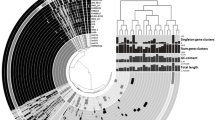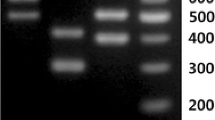Abstract
Real-time polymerase chain reaction (RT-PCR) was used to quantify seven species of lactic acid bacteria (LAB) in alfalfa silage prepared in the presence or absence of four commercial inoculants and in uninoculated corn stover harvested and stored under a variety of field conditions. Species-specific PCR primers were designed based on recA gene sequences. Commercial inoculants improved the quality of alfalfa silage, but species corresponding to those in the inoculants displayed variations in persistence over the next 96 h. Lactobacillus brevis was the most abundant LAB (12 to 32% of total sample DNA) in all of the alfalfa silages by 96 h. Modest populations (up to 10%) of Lactobacillus plantarum were also observed in inoculated silages. Pediococcus pentosaceus populations increased over time but did not exceed 2% of the total. Small populations (0.1 to 1%) of Lactobacillus buchneri and Lactococcus lactis were observed in all silages, while Lactobacillus pentosus and Enterococcus faecium were near or below detection limits. Corn stover generally displayed higher populations of L. plantarum and L. brevis and lower populations of other LAB species. The data illustrate the utility of RT-PCR for quantifying individual species of LAB in conserved forages prepared under a wide variety of conditions.

Similar content being viewed by others
References
Berthier F, Ehrlich SD (1998) Rapid species identification within two groups of closely related lactobacilli using PCR primers that target the 16S/23S rRNA spacer region. FEMS Microbiol Lett 161:97–106
Bolsen KK, Ashbell G, Weinberg ZG (1996) Silage fermentation and silage additives: review. Asian-Austr J Anim Sci 9:483–493
Coeuret V, Gueguen M, Vernoux JP (2004) Numbers and strains of lactobacilli in some probiotic products. Int J Food Microbiol 97:147–156
Collins MD, Rodrigues UM, Ash C, Aguirre M, Farrow JAE, Martinez-Muchia A, Phillips BA, Williams AM, Wallbanks S (1991) Phylogenetic analysis of the genus Lactobacillus and related lactic acid bacteria as determined by reverse transcriptase sequencing of 16S rDNA. FEMS Microbiol Lett 77:5–12
Collins MD, Samelis J, Metazopoulos J, Wallbanks S (1993) Taxonomic studies on some leuconostoc-like organisms from fermented sausages: description of a new genus Weissella for the Leuconostoc paramesenteroides group of species. J Appl Bacteriol 75:595–603
Dellagio F, Torriani S (1986) DNA–DNA homology, physiological characteristics and distribution of lactic acid bacteria isolated from maize silage. J Appl Bacteriol 60:83–92
Felis GE, Dellaglio R, Mizzi L, Torriani S (2001) Comparative sequence analysis of a recA gene fragment brings new evidence for a change in the taxonomy of the Lactobacillus casei group. Int J Syst Evol Microbiol 51:2113–2117
Furet JP, Quenee P, Talliez P (2002) Quantification de bacteries lactiques par PCR quantitative. Sci Aliments 22:33–44
Grattepanche F, Lacroix C, Audet P, Lapointe G (2004) Quantification by real-time PCR of Lactococcus lactis subsp. cremoris in milk fermented by a mixed culture. Appl Microbiol Biotechnol 66:414–421
Grazia L, Suzzi G (1984) A survey of lactic acid bacteria in Italian silage. J Appl Bacteriol 56:373–379
Klocke M, Mundt K, Idler, C, McEniry J, O'Kiely P, Barth S (2005) Monitoring Lactobacillus plantarum in grass silages with the aid of 16S rDNA-based quantitative real-time PCR assays. Syst Appl Microbiol (in press; DOI:10.1016/j.syapm.2005.06.001)
Lin C, Bolsen KK, Brent BE, Dung DYC (1992) Epiphytic lactic acid bacteria succession during the pre-ensiling and ensiling periods of alfalfa and maize. J Appl Bacteriol 73:375–387
Lindgren S, Pettersson K, Jonsson A, Lingvall P, Kaspersson A (1985) Silage inoculation: selected strains, temperature, wilting and practical application. Swed J Agric Res 15:9–18
Matsuki T, Watanabe K, Fujimoto J, Kado Y, Takada T, Matsumoto K, Tanaka R (2004a) Quantitative PCR with 16S rRNA-gene-targeted species-specific primers for analysis of human intestinal bifidobacteria. Appl Environ Microbiol 70:167–173
Matsuki T, Watanabe K, Fujimoto J, Takada T, Tanaka R (2004b) Use of 16S rRNA-gene-targeted group-specific primers for real time PCR analysis of predominant bacteria in human feces. Appl Environ Microbiol 70:7220–7228
McDonald P, Henderson N, Heron S (1991) The biochemistry of silage. Chalcombe, Marlow
Muck RE (1991) Silage fermentation. In: Zeikus JG, Johnson EA (eds) Mixed cultures in biotechnology. McGraw-Hill, New York, pp 198–204
Rooke JA, Kafilzadeh F (1994) The effect upon fermentation and nutritive value of silages produced after treatment by three different inoculants of lactic acid bacteria applied alone or in combination. Grass Forage Sci 49:324–333
Sambrook J, Fritsch EF, Maniatis T (1989) Molecular cloning: a laboratory manual, 2nd edn. Cold Spring Harbor Press, New York
Seale DR, Henderson AR, Pettersson KO, Lowe JF (1986) The effect of addition of sugar and inoculation with two commercial inoculants on the fermentation of lucerne silage in laboratory silos. Grass Forage Sci 41:61–70
Settanni L, van Sindern D, Rossi J, Corsetti A (2005) Rapid differentiation and in situ detection of 16 sourdough Lactobacillus species by multiplex PCR. Appl Environ Microbiol 71:3049–3059
Tajima K, Aminov RI, Nagamine T, Matsui H, Nakamura M, Benno Y (2001) Diet-dependent shifts in the bacterial population of the rumen revealed with real-time PCR. Appl Environ Microbiol 67:2766–2774
Torriani S, Felis GE, Dellaglio F (2001) Differentiation of Lactobacillus plantarum, L. pentosus, and L. paraplantarum by recA gene sequence analysis and multiplex PCR assay with recA gene-derived primers. Appl Environ Microbiol 67:3450–3454
Acknowledgements
This research was supported by the Agricultural Research Service, US Department of Agriculture, CRIS projects 3655-41000-004-00D and 3655-31000-018-00D. We thank Dave Spangler (Agri-King, Inc.) for providing cultures. We also thank Alltech, Inc., Chr. Hansen Biosystems, Genus Breeding Ltd., and Pioneer Hi-Bred International for providing bacterial inoculant products.
Author information
Authors and Affiliations
Corresponding author
Additional information
Disclaimer: Mention of products is for informational purposes only and does not imply a recommendation or warranty by USDA over other products that may also be suitable
Rights and permissions
About this article
Cite this article
Stevenson, D.M., Muck, R.E., Shinners, K.J. et al. Use of real time PCR to determine population profiles of individual species of lactic acid bacteria in alfalfa silage and stored corn stover. Appl Microbiol Biotechnol 71, 329–338 (2006). https://doi.org/10.1007/s00253-005-0170-z
Received:
Revised:
Accepted:
Published:
Issue Date:
DOI: https://doi.org/10.1007/s00253-005-0170-z




